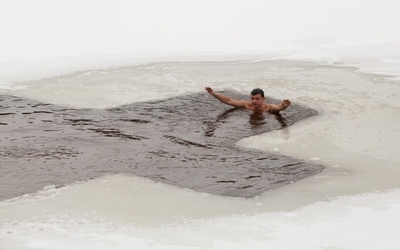Exhilarating Experience: How to Dive Into Winter Swimming
Swimming in the winter may have a certain spontaneous appeal, but it’s better for your fitness and overall wellbeing if you’re prepared. Don’t let this put you off; winter swimming is completely exhilarating, so here’s how to dive in.
1. Be safe: According to wellness writer Nell Frizzell, ‘Anyone with a heart condition and asthma has good reason not to attempt winter swimming at all. Talk to a GP beforehand if you have any concerns, but also bear in mind that thousands of people swim outdoors safely every year…Winter swimming is a refreshing, life-affirming and exhilarating experience, silencing that relentless inner monologue of worry, doubt and things to do. Swimming in Britain is also extremely safe, and as long as you take a few basic precautions you’ll have a wonderful time.’
2. What to Wear: ‘The sea is at its warmest in September,’ notes Frizzell. ‘When the sun has been heating it all summer. It’s at its coldest in April, so February temperatures can be a pleasant surprise. You can wear a wetsuit if it makes you feel more confident, but I prefer a swimsuit so my body is in contact with the cold water – once you get used to the temperature, it’s a lovely experience. A wool hat over a swimming cap keeps your head warm, and wetsuit gloves and slippers will protect your extremities.’
3. Play it Safe: Frizzell cautions, ‘The sea is often much rougher in winter, so be sensible about where you swim. Do a bit of homework – there are lots of good videos online of what a rip tide looks like. Never go out of your depth, and if you’re swimming in rivers, lakes, pools or ponds, always make sure you’ve identified where you can climb out before you leap in, avoiding seaweed-slicked or steep-sided rocks. It’s also a good idea to have someone keeping an eye on you, just in case something goes wrong. Or, even better, find a friend to swim with you and you can spur each other on.’
4. Getting in: ‘I break it down into five stages,’ says Frizzell. ‘First, go in up to your knees. Wait a few seconds, then wade out to your middle. Check you feel comfortable and the water is calm. Then slide out so the water is over your chest. Give your heart a couple of beats to adjust, and then: plop – you’re ready to dive in. Not everyone likes going underwater but, for me, there is nothing like the electrifying flash of cold water across your head. Once you’re in, don’t feel pressure to swim very far – relax, this is about pleasure, not burning calories.’
5. The Swim Itself: Frizzell details, ‘After a few seconds in the water, my arms and legs start to tingle, then my toes and fingers go pale and numb. This is nothing to worry about. But listen to your body – unless you swim every day you won’t have had a chance to build up resistance to the cold, so don’t stay in any longer than about two minutes…And don’t forget to enjoy it! Relish the unfamiliar perspective of an empty, windswept beach and snow-dusted cliff tops.’
6. Getting Out: Frizzell comments, ‘The rush of adrenaline will make you feel warm for a few minutes after you get out, but you should immediately strip off, rub yourself down and get as dry as you can before you start shivering. If possible, get under a warm shower or stand in a tub of warm water – but don’t heat your body up too fast. Then start to layer up; lots of thin layers are better than just one big, chunky jumper, and a hat will keep your head warm. Keep moving, stamp your feet, rub your hands and let the endorphins wash over you.’


Comments are closed.